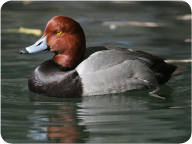 Redhead Duck
Redhead Duck
Aythya americana
Description
The Redhead is a medium sized duck that is known for the male’s bright red head coloration. The male also has a black neck, a gray back and a white belly. The female is uniformly brown in color.
Size
Redheads measure 18-22 inches in length with a wingspan of 33 inches. They weigh 2 to 2.5 pounds.
Adaptations
- One reason ducks are able to stay afloat in the water is because of air sacs inside their bodies that increase their buoyancy.
- Ducks’ feathers trap air in between them, which is another adaptation that helps them to float. Their feathers are also covered with a waterproof substance that keeps the ducks warm and dry.
- Ducks’ webbed feet allow them to maneuver easily in the water.
- Ducks are excellent fliers due to their streamlined bodies and powerful wings. Ducks and other birds also have hollow bones that weigh much less than the solid bones of mammals. This reduces their overall body weight and makes them light enough to fly.
- Ducks do not have teeth, but they do have bumpy edges on their bills that help them to filter food out of the water. Food is then swallowed and ground up in the gizzard, a part of the stomach that contains small rocks for breaking down food.
Diet
In the wild, Redheads are primarily vegetarian, diving underneath the water to eat aquatic plants and algae. Their diet also includes some insects and shellfish. At Cosley Zoo, the ducks are fed a commercially prepared waterfowl diet.
Reproduction
Redheads begin forming pairs in April. In midsummer, the female uses grasses and other plants to build a nest, which she then fills with down. She lays 10-14 eggs at a time. Occasionally, female Redheads will lay their eggs in the already-built nests of other ducks. When the last egg is laid, a 25-day incubation period begins. After the eggs hatch, the female remains with the juveniles until they are able to fly at about 8-10 weeks of age.
Shelter and Space Needs
The Redhead’s habitat includes shallow freshwater lakes, ponds, and marshes. The body of water needs to be at least 28 inches deep so that the ducks can dive. Marshes also provide an area rich with aquatic plants and vegetation for protection from predators. Redheads migrate for the winter, primarily to the Gulf States and Mexico.
Life Expectancy
Uncertain for this breed. In general, ducks live an average of 2 years in the wild and can live over 10 years in captivity.
Relationship With Man
Redheads are popular with many duck hunters, and money spent on hunting licenses supports the conservation of wild animals and their habitat.
Fun Facts
- Redhead ducks can make some unusual noises. The female Redhead makes a quacking noise, but the male’s vocalization can sound like a cat’s meow or purr!
- The water in the Cosley Zoo duck pond often looks green, but that’s not because it’s dirty! The green dye that we put in there helps to block sunlight, which keeps algae from taking over the pond.
- A group of ducks is called a brace.






